Porcelain stoneware for the floor: the subtleties of choice and installation

Several decades ago, a new material appeared on the flooring market - porcelain stoneware. He instantly attracted the attention of not only experienced craftsmen, but also ordinary users. In a fairly short period of time, this coating has gained considerable popularity. This is due to the fact that this material very successfully combines all the necessary qualities both in terms of aesthetic design and in terms of operation.
The unique technical characteristics of this coating, as well as the variety of textures and a wide selection of color solutions, make it possible to use porcelain stoneware tiles in facing work on various objects. It is perfect for furnishing apartments and houses, as well as personal plots. That is why it is worth learning in more detail about the features of this material, its varieties and some of the advantages.


Peculiarities
The structure of porcelain stoneware is very often compared to glass, so it is impossible to deny the fact that it can also break. However, this does not speak of it as a fragile material. Moreover, it is necessary to make tremendous efforts to find worthy competitors for it in terms of strength.
In this case, concepts such as hardness and fragility are completely different terms. It is possible to break porcelain stoneware tiles if the installation rules are not followed, as well as during careless transportation. However, after proper installation of porcelain stoneware, there is no doubt about its strength.
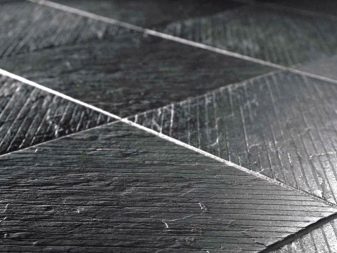

Plates of this type are made with a thickness of 4 to 30 millimeters. The most popular should be considered from 10 to 14 mm. They are most often used for flooring in various rooms. It should be noted that the cost of this material directly depends on the thickness indicators. Also, the price is influenced by its color and texture. But despite the high costs, buyers are still satisfied, since the properties of such tiles fully justify the costs.
There is a possibility of making tiles to order. Their thickness is three centimeters. With such parameters, they still show extraordinary strength and durability. These characteristics do not depend on the thickness of the product, but on the quality of the installation. Therefore, you can find a low-quality cladding made of a denser material, which turns out to be unstable to mechanical stress.


The mixture for porcelain stoneware contains different types of clay, feldspar, refined quartz sand, as well as metal oxides, which are coloring pigments. It should be noted that all components are exclusively of natural origin.
The components used in the production of porcelain stoneware tiles are mined in quarries. Moreover, clay, which is one of the main components, has a certain composition of chemical elements. The quality of the future product directly depends on this condition. At the plant, a specific vessel is used for each individual grade of clay, since in the future, all components are mixed in strict observance of carefully calculated proportions.
After that, the finished mixture is transferred to the mills, where it is ground.The resulting batch is piled in silos. It is here that porcelain stoneware is stored until the moment of firing and pressing.


Thanks to such a complex production technology, this material has received recognition among users. Its performance properties are suitable for both interior and exterior cladding, however, porcelain stoneware is especially widespread as a floor covering.
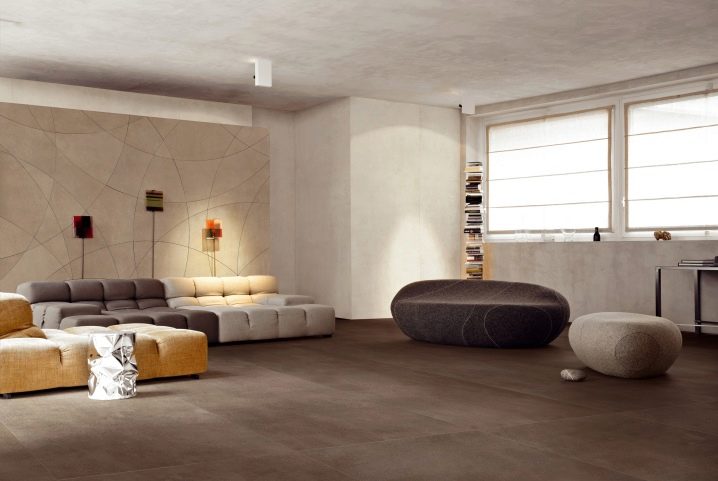
How is it different from floor tiles?
Quite often, porcelain stoneware is confused with ceramic tiles. Indeed, these materials are similar not only in appearance, but also in composition and performance. However, there is a significant difference between them. It lies in the technology that manufacturers use. Therefore, porcelain stoneware tiles, in comparison with their progenitor, have no voids inside, microcracks and porosity.
It is these properties that make it more durable and provide high strength. Also, it is not so susceptible to temperature changes and copes well with various kinds of external influences. Due to the presence of such qualities superior to ceramic tiles, this material is chosen for flooring in various rooms.
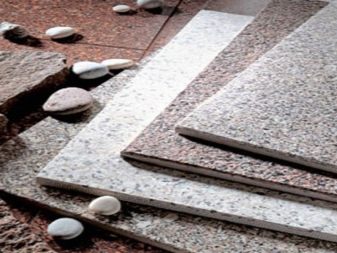

It should be added that porcelain stoneware has a hardness index of 8-9 points on the Mohs scale. Moreover, even natural granite is limited to the number 6. And the most durable material is corundum, which is only 1-2 units denser than porcelain stoneware.
To distinguish porcelain stoneware from the usual ceramic tiles, just look at its cut. The coloring pigment is visible throughout the entire depth, because, unlike ceramics, in the production of porcelain stoneware, it is added at the very beginning.
Properties and characteristics
After studying some of the differences between porcelain stoneware and ordinary ceramic tiles, as well as natural granite, you should learn in more detail about the main properties and characteristics of the material described.
Here are the criteria that deserve special attention:
- Strength;
- Moisture resistance;
- Wear resistance;
- Format;
- Thickness;
- Resistance to loads.


Enough has been said about the durability of porcelain stoneware tiles. Therefore, it is worth recalling only that in this parameter it is surpassed only by corundum. Therefore, there is no doubt that this material will show the proper qualities.
Low porosity provides good resistance to moisture. Therefore, there is practically no water absorption in porcelain stoneware. This figure is only 0.05%. That is why it is used for cladding facades. Moreover, you can apply any of the types presented.


Also, due to the hydro-barrier, this material is able to withstand rather low temperature conditions, even -50 degrees. It is worth noting that a simple ceramic tile loses its quality rather quickly with negative thermometer readings.
The next important characteristic is the wear resistance of the tiles. Its abrasion resistance is usually calculated on the PEI scale.
She, in turn, is divided into 5 classes:
- for walls;
- for flooring in a residential area in which low traffic is expected;
- for places with average traffic (about a hundred people per hour);
- for public places;
- for places with heavy traffic.



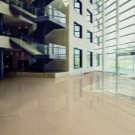


The latter include airports or train stations. The packaging will help determine the level of durability. On it, the named categories are indicated by the manufacturer in the form of Roman numerals.


Porcelain stoneware is available in different formats. The choice of tile size should be selected based on the parameters of the room. So, large slabs do not always fit into a small space. In this case, the main criterion for quality is not at all the aesthetic side, but the question of the service life of the cladding.




This is due to the fact that, for example, for porcelain stoneware tiles with a 60x60 cm format, a better base and glue are needed. And for slabs 30x30 cm, such conditions are not put forward. Therefore, an alternative is considered a product whose size is 45x45 cm. It is the plates of this format that designers note as the most optimal solution suitable for any room. In addition, they are quite undemanding during installation and adequately respond to some base errors.
It is necessary to say about the possibility of porcelain stoneware to resist loads. So, the highest indicator of the load that this material can withstand is 2000N. It should be noted that this property is in direct proportion to other characteristics, such as thickness or size. However, when testing the ceramic granite, a truck weighing 30 tons was used. At the same time, the tile was used in a large size, which withstood such a load with dignity.



Knowing about such outstanding properties of porcelain stoneware, it is simply impossible to ignore it when choosing a material for flooring.

Pros and cons of finishing
Despite the abundance of worthy and competitive characteristics of ceramic granite, one should not forget both the advantages and possible disadvantages of finishing the premises with this material.



In addition to high strength and excellent performance, ceramic tiles have a number of advantages.
Among them, the following criteria should be highlighted:
- high degree of protection of facades against corrosion. This becomes possible due to qualities such as endurance at various temperatures, as well as moisture tolerance;
- availability of a wide range. Porcelain stoneware is an artificial creation of manufacturers and is made in factories. That is why it is presented on the market in all kinds of shapes, textures, sizes and colors. Thus, among such a variety, you can easily find an option that will fit into any design style;
- reduction of cash costs for building renovations in the future. The high cost of ceramic granite fully pays off due to its positive qualities and saves the owner from the cost of possible alterations in the future;
- providing comfort indoors;
- the ability to create a unique design due to the abundance of aesthetic properties;
- additional protection from the outside (when it comes to finishing the wall covering);
- resistance to pollution.


In addition to the above factors, the advantages of porcelain stoneware include fire resistance, long service life, as well as sound insulation and much more. It is these qualities that bring it to the first positions in the list of other finishing materials.
However, despite the above advantages, porcelain stoneware tiles are not without some disadvantages.
Among the small number of disadvantages are the following:
- the high cost of the product and the styling itself;
- the porcelain stoneware floor is not warm enough. However, this can be corrected by insulation;
- massiveness. It is this factor that makes the delivery and installation of this material laborious. In addition, sometimes additional processing of the base may be required.


Despite these disadvantages, the advantages still greatly outweigh them. That is why experienced craftsmen compare all the above criteria and ultimately opt for ceramic granite. They are well aware that with a competent approach, any flaw can be turned into a virtue.
Varieties
Today there are several varieties of porcelain stoneware. They are determined by various parameters:


To size
Tiles of different sizes are required for one or another design. In some cases, small formats are required, and in others - large ones, the size of which reaches 1200x600 mm.However, most often in the decoration there are medium-format square slabs. Their sides vary from 200 to 500 mm. Due to the possibility of choosing tiles by this parameter, its scope of application is significantly expanded. That is why porcelain stoneware is suitable for both external and internal cladding.




By texture and texture
To begin with, it should be noted that ceramic granite is in great demand in the classic design style. This is due to the fact that this flooring material looks very similar to natural stone. And as you know, it is he who most favorably emphasizes the beauty of classic design. However, manufacturers do not sit idly by and are constantly improving the manufacturing technology. It is with this that the appearance of such types of porcelain stoneware is connected.



By surface type
- Glazed, semi-polished (lapped) and polished;
- Matte and glossy, as well as unpolished;
- With relief - structured;
- Covered with wax;
- Rectified.






The selection of this or that type of porcelain stoneware tiles completely depends on the designer's idea., as well as the practical side of the room itself. So, for example, for buildings that position themselves as trade or exhibition, it is more expedient to choose a surface with a relief. Production-type premises will be reliably protected by thickened or antistatic finishing. If there is a possibility of frequent dirt in the premises, then a glazed coating will be the ideal solution.


In addition, manufacturers have taken care of the owners' desire for originality. Therefore, on the market you can find products from porcelain stoneware with imitation of concrete, metal, leather, fabrics and much more.




Design and color options
Thanks to a large selection of shapes, textures, sizes and textures, using porcelain stoneware tiles, you can easily bring to life the most daring design projects. In addition, the manufacturers have not forgotten about the appearance of their products. Therefore, today it is quite easy to find tiles of any color and design.
In its standard form, porcelain stoneware looks like natural granite. However, even this embodiment can be varied by adding a certain paint. So, you can often find flooring made of ceramic granite, for example, black or white. Also, marble and stone finishes have become very popular.






In residential premises with a low level of load, porcelain stoneware tiles are often used, made under parquet or under a laminate. This solution allows you to bring coziness due to the named surfaces, but at the same time they receive all the invaluable qualities of porcelain stoneware.




In addition to the above, products with drawings deserve special attention. With their help, you can bring a certain storyline into the interior, which can be extended to the entire design. Especially such models are actively used in exhibition halls, adding a touch of sophistication and thus emphasizing the purpose of the room.



Fans of non-standard solutions manage to make a mosaic floor covering using porcelain stoneware tiles. This design is called patchwork. It can also be found in public places.

Matt porcelain stoneware is worth mentioning separately. Its cost is the most affordable in comparison with other types of this material. At the same time, it retains all important characteristics and looks very attractive.


From the foregoing, it follows that, despite their cumbersomeness, ceramic granite products are distinguished by their versatility and are able to decorate with their presence various buildings and individual rooms. Their relevance is guaranteed in any of the existing styles. This is ensured by the possibility of choosing a color scheme, as well as by the variety of designs of the tiles themselves.
How to choose for different rooms?
One of the first and most important questions when decorating the interior of your home, which must be solved, is the choice of porcelain stoneware tiles for each specific room. In Russia, the interior finishing of the floor surface with this material has not been a novelty for a long time. With its help, designers add sophistication to the design of any room.
You should familiarize yourself with some recommendations regarding which type of porcelain stoneware is best used in a particular room. After all, each room is unique in its own way. Due to its unique characteristics and properties, porcelain stoneware tiles are a versatile finish, since from the variety offered, you can find a suitable option both for an entrance hall or balcony, as well as for a bedroom or living room.

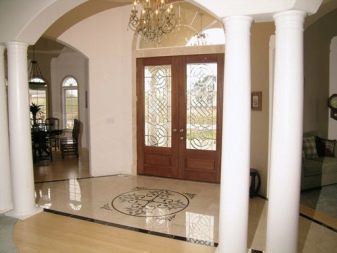
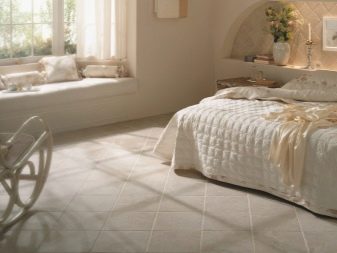

More recently, it was quite difficult to imagine such a material as ceramic granite as a floor decoration in a living room. It was often used as usual in rooms such as the kitchen or bathroom. This is due to the practicality of porcelain stoneware and its simplicity in care and operation. This material was used taking into account precisely these qualities, and not as an interesting design approach.

Today, thanks to the constant improvement of production technology, porcelain stoneware tiles are suitable for use as a material for decorating even rooms for daily use. In addition to the wide range of offered porcelain stoneware products, one should not forget about the possibility of connecting a floor heating system to them.
Thus, in the hall, you can equip a beautiful and reliable floor covering, which at the same time will be quite warm. This means that comfort will always be present in the living room.


The floors in the hallway and corridor have special operating conditions. It is this part of the dwelling that is considered the most passable. In addition, there is often movement in street shoes, and the surface is exposed to constant mechanical stress (bags, strollers, etc.). All this after a while is expressed in some deterioration in the state of the tile. Therefore, when choosing porcelain stoneware in the hallway, you should take into account the listed nuances.
First of all, when choosing ceramic granite tiles in the corridor, you should carefully study the packaging. It indicates the degree of wear resistance. In this case, it is more expedient to buy products with indicators III or IV. Despite the large daily cross-country ability, this will be quite enough. After all, we are not talking about the station, but about the apartment.




To add aesthetics to a given space, designers often combine several variations to create a complete picture. It also allows you to combine or separate the corridor and hallway.
The most common combinations are:
- Tiles for wood and stone;
- Monochromatic products with small splashes;
- Abstractions and geometric patterns.



It is worth noting that when buying products in large quantities, it is necessary to carefully review the shades and textures. Quite often, there are cases when tiles from different batches may have minor differences in these parameters.
Modern designers experiment not only with combinations of one material, but also combine several different ones. So, for the second coating, you can opt for ceramic tiles, linoleum, parquet or laminate. With a competent approach to this issue, you can get the original design of the hallway. This solution will be especially appropriate for a long room. This combination will visually revive it.


For lovers of more traditional ideas, there is also a way out: porcelain stoneware with wood imitation will look very beneficial in the corridor and hallway. In addition, such an embodiment of it will add warmth and comfort to the interior.

When choosing a floor covering for a kitchen, it is necessary to be guided not only by the aesthetic side of the issue, but also to take into account the purpose of this space. Therefore, it is very important to pay attention to the technical characteristics of the material. In this situation, ceramic granite is the right choice. Tiles made from it will last a long time. At the same time, its appearance may deteriorate slightly, despite all kinds of pollution, even the most serious. Moreover, the wide range allows you to choose the right design for other interior decoration elements, which can also be made of porcelain stoneware tiles.




The next room, which perfectly complements the porcelain stoneware cladding, is the bathroom.
Based on the variety of textures and properties that modern manufacturers endow their products with, you should choose tiles according to the following criteria:
- Anti-slip qualities (help to avoid injury even if the floor surface is wet);
- Moisture resistance, as well as persistent tolerance of detergents and abrasives;
- Resistance to various kinds of mechanical stress (scratches, impacts, etc.);
- Durability.






Experts do not recommend using corrugated tiles, since cleaning it is a rather laborious process. It is more expedient to restrict the bathroom to finishing the floor from a rough or smooth material. When it comes to durability, you should choose a product labeled I, II or III when purchasing. It is worth noting that the first two indicators are intended specifically for the bathroom.


In order for the surface to adequately withstand the effects of various chemicals that are used when cleaning it, it must have the lowest possible porosity. In this case, the level of resistance should reach a high mark.
On the packaging of the product, such indicators are usually indicated as follows:
- Foot pattern and shaded background - high level of wear resistance;
- A foot on a black background is a product for floor cladding.
In addition, some manufacturers indicate the presence of anti-slip properties.


Another area where porcelain stoneware can be used as a flooring is a balcony. This material is especially suitable for unheated or non-glazed structures. In addition, it is the balcony that is exposed to the weather. Therefore, porcelain stoneware floor tiles will be a real boon for this room. It should be noted that in an open space, it is best to give preference to products with anti-slip properties.



All of the above confirms the versatility of porcelain stoneware. Its extensive characteristics and design incarnations are suitable for absolutely any style of home decoration, as well as its exterior decoration.
Styling
When the choice of material has been made, you should familiarize yourself with some of the features of its installation.
To lay out the tiles correctly, you must adhere to certain rules:
- Bearing in mind the high cost of porcelain stoneware, it is most correct to make the necessary calculations in advance and indicate the required amount. In order not to miss anything, it is recommended to draw up a diagram of the site itself on which the installation is planned. However, we must not forget that with such work, there should always be a small margin in case of pruning.
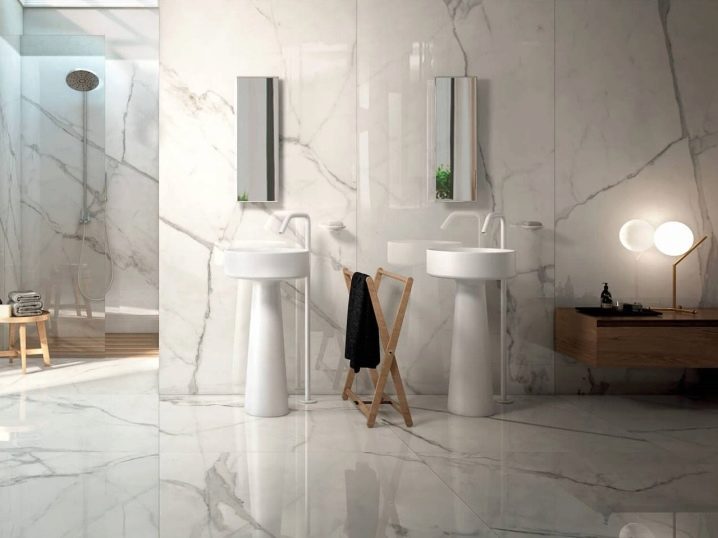
- Before starting installation, it is important to make sure that all boards are of the same shade and format. If you bought products with a pattern, then you need to check its alignment. To do this, take several tiles from different packages and compare them with each other.
- After that, you need to prepare the foundation for the future surface. It should be flawless. If at the same time some irregularities were found, then you should get rid of them with a primer.
- The next step is to cut the slabs.Due to the high strength of the material, it will be very difficult to do this at home using a grinder and tile cutter, especially if the design project involves a large number of flaps. Therefore, a more correct solution in such a situation would be to give porcelain stoneware for cutting. The workshop will certainly make sure that the result does not differ from the factory source.
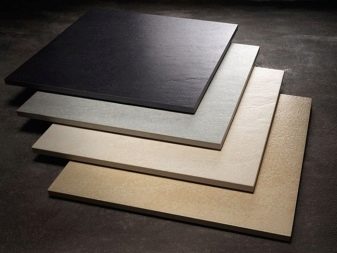

- After such preparations, you can proceed to the installation itself. First, lay out the first row. Next, you need to draw a straight line along the lower border using a laser level, which is indicated according to a previously drawn up scheme.
- Separately, the correct choice of glue should be indicated. It is worth remembering that its quality directly depends on the width of the tile, as well as its weight. In addition, the adhesive solution is selected taking into account the characteristics of the room in which the porcelain stoneware is being installed. For example, a bathroom requires moisture-resistant glue. It is kneaded until the consistency of sour cream and infused for some time.
- The mortar is applied to the boards and the excess is removed with a notched trowel.
- Next, you should attach the tiles to the floor and press down a little. After that, it is shifted to the desired point. You can mark the grooves with plastic crosses. In order for the gluing process to be completed completely, it is necessary to knock around the perimeter of the entire tile.
- After that, the first row is glued in accordance with the indicated line. All slabs must be in the same plane. And if we are talking about patterned porcelain stoneware, it is important to follow the pattern.
- By the same principle, the remaining rows are laid in strict accordance with the drawn diagram.
- After the porcelain stoneware tiles are dry, you can move on to grouting. Mastic will perfectly cope with this task. Such a putty will only strengthen the properties of porcelain stoneware.


See the next video for more on this.
Many are interested in the possibility of laying ceramic granite tiles on a wooden floor. In this respect, the masters have contradictions. Some consider it useless, others - on the contrary, a very practical solution. If you nevertheless decide to install porcelain stoneware on a wooden floor, then special attention should be paid to its surface:
- First you need to strengthen the base with screws and, if possible, lay plywood boards. This will help get rid of unwanted kinks that may have formed earlier. This point is very important, since the durability of the future coating depends on it.
- It is necessary to make high-quality waterproofing of the base, since it is undesirable for moisture to get on the tree, even from the glue solution.
- It is recommended to use epoxy adhesive and putty. They are more flexible and easier to adhere to waterproof surfaces.
Otherwise, the process of laying ceramic granite tiles on a wood base fully complies with the above rules.



Tips for use and care
Since porcelain stoneware is quite unpretentious in maintenance, taking care of the flooring will not be difficult. In addition, the implementation of some of the tips will significantly increase its service life.
Upon completion of the repair work, it is necessary to remove the remnants of the various materials that are used during installation as soon as possible. When the glue or cement is completely dry, scrubbing will become very difficult, which will affect the appearance of the tile.
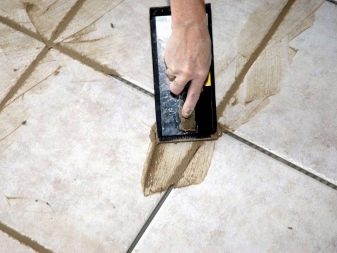

That is why the new surface should be treated with a light acid solution. When choosing a cleaning agent, you need to take into account the degree of contamination of ceramic granite, as well as its toxicity. It is not recommended to use a substance that has a negative effect on the human body. This precautionary measure will help you avoid potential unpleasant health problems.
The cleaning agent should be applied to the entire surface area. It should stay on it for some time. On average, this interval is 30-60 minutes. After this period, the coating is washed with water. And for greater efficiency, a brush is used. After such manipulations, it is enough to wipe the tile with a dry cloth.


Sometimes experts recommend using polishing products. In their opinion, polishing will help keep porcelain stoneware in its original form for a longer period.
Manufacturers and reviews
The birthplace of porcelain stoneware is Italy. In the 70s of the last century, it was presented to the whole world. Thanks to its unique consumer qualities, the production of ceramic granite in other countries began to actively develop.
For example, Spain quickly adopted these skills and also started making porcelain stoneware tiles. Moreover, it should be noted that Spanish porcelain stoneware, like Italian, is considered one of the best of its kind. However, domestic producers did not stand aside, and today you can find a huge amount of Russian and Belarusian porcelain stoneware on the market.




It should be noted that domestic products are not inferior to foreign ones in terms of quality characteristics. This is possible thanks to the use of similar technologies, as well as partnerships among companies.


Among the most popular manufacturers, the following are worth highlighting:
- Kerama Marazzi;






- Italon;
- Estima;




- Grasaro.


All products manufactured by these companies comply with quality standards and have all the necessary certificates. In addition, the stated requirements are fully consistent with the Italian ones. And the equipment itself, with the help of which they are produced, also most often comes from Italy.
In addition, there are Chinese companies that also manufacture porcelain stoneware. Of course, their products stand out from the rest of the more affordable cost.

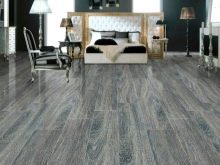

However, it is wiser to buy goods from a trusted supplier. This fact is confirmed by user reviews. Complaining about the high cost of the product, customers are still satisfied that they have made a choice in favor of a well-deserved company. They point out that all expenses really have a 100% return on investment. Those who are already lucky enough to have a porcelain stoneware floor finish in their home advise others to test all the declared properties and characteristics of the product.
Examples in the interior
Porcelain stoneware tiles perfectly complement the cozy atmosphere in the living room. A light and unobtrusive panel-style pattern adds sophistication to the entire interior of the room.
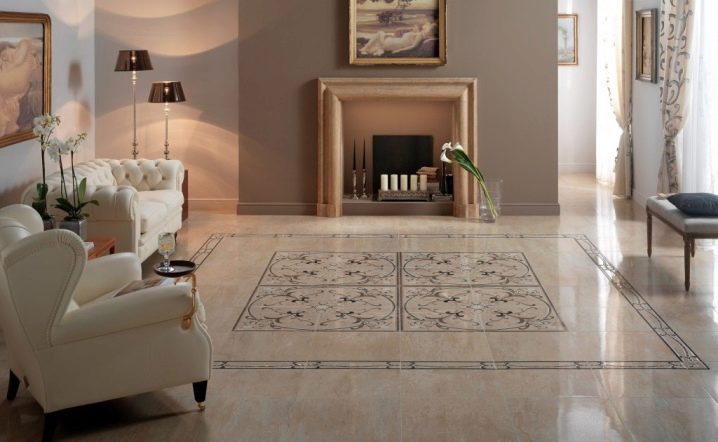
Porcelain stoneware flooring in the hallway. A simple and practical solution for an attractive design.


Bathroom cladding with large porcelain stoneware tiles. The design speaks of perfection and comfort.


Porcelain stoneware floor in the kitchen. The mirror finish is proof of correct installation and surface care.


Thanks to the variety of textures and shades, a cozy atmosphere in the bedroom can be achieved even with the help of porcelain stoneware tiles.
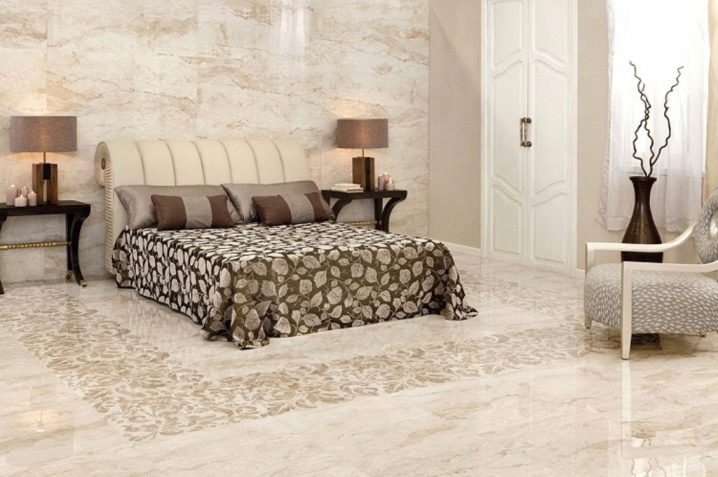













The comment was sent successfully.